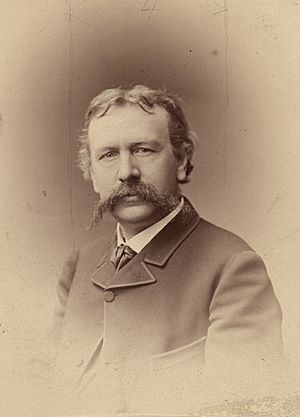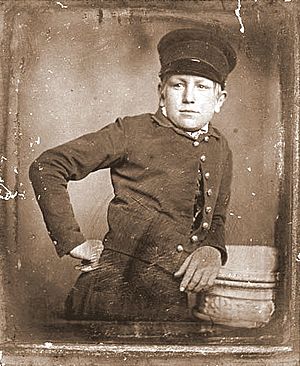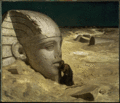Elihu Vedder facts for kids
Quick facts for kids
Elihu Vedder
|
|
|---|---|

Elihu Vedder, 1870
|
|
| Born | February 26, 1836 |
| Died | January 29, 1923 (aged 86) |
| Nationality | American |
| Known for | Drawing Oil painting Mural painting |
| Movement | Realism; Pre-Raphaelites |
| Spouse(s) | Caroline Rosekrans |
Elihu Vedder (born February 26, 1836 – died January 29, 1923) was an American artist. He was known for his symbolist paintings, book illustrations, and poems. Vedder was born in New York City.
He is most famous for his 55 drawings for a special edition of The Rubaiyat of Omar Khayyam. This book was a translation by Edward FitzGerald.
Contents
Elihu Vedder's Early Life
Elihu Vedder was born on February 26, 1836, in New York City. His parents were Dr. Elihu Vedder Sr. and Elizabeth Vedder. They were cousins. His father was a dentist who moved to Cuba to try new things. This greatly affected young Elihu's childhood.
He spent the rest of his childhood living with his grandfather, Alexander Vedder, in Schenectady. He also attended a boarding school. Elihu's mother supported his dream of becoming an artist. His father was not so sure, thinking his son should choose a different job. Elihu's brother, Dr. Alexander Madison Vedder, was a Navy surgeon. He saw Japan change into a modern country while he was working there.
Becoming an Artist
Vedder studied art in New York City with Tompkins H. Matteson. Later, he went to Paris to train with François-Édouard Picot. He finished his art studies in Italy. There, he was greatly inspired by old Italian Renaissance art. He also liked the modern Macchiaioli painters and the beautiful Italian countryside.
He first visited Italy from 1858 to 1860. During this time, he became very close friends with another painter, Giovanni Costa. They enjoyed peaceful trips through the Italian countryside. However, these trips ended when Vedder's father stopped sending him money.
Without money, Vedder returned to the United States during the American Civil War. He earned a small living by creating drawings for businesses. He was part of a group of artists and writers at a coffee house called 'Pfaff's'. During this time, he painted some of his most famous works. These paintings were known for their dream-like quality, romantic ideas, and often showed influences from the Middle East. Some of these paintings include 'The Roc's Egg', 'The Fisherman and the Genii', and 'Lair of the Sea Serpent'. In the United States, Vedder met and became friends with famous writers like Walt Whitman and Herman Melville. He also befriended artist William Morris Hunt. In 1865, Vedder became a member of the American Academy of Arts and Letters. After the Civil War ended, Vedder left America to live in Italy.
Family Life and Later Career
Elihu Vedder married Caroline Rosekrans on July 13, 1869, in Glen Falls, New York. They had four children, but only two lived to adulthood. His daughter, Anita Herriman Vedder, helped him a lot with his business matters. Elihu's son, Enoch Rosekrans Vedder, was a promising architect. Enoch passed away in Italy on April 2, 1916, while visiting his parents.
Elihu Vedder had a home in Rome. After his Rubaiyat illustrations became very popular in 1884, he also bought a home on the Isle of Capri. This island was a popular spot for artists at the time.
Vedder visited England many times. He was influenced by the Pre-Raphaelites, a group of English painters. He was also a friend of the artist Simeon Solomon. Vedder was also inspired by the works of English and Irish mystical writers like William Blake and William Butler Yeats. In 1890, Vedder helped start the In Arte Libertas group in Italy.
The company Tiffany asked him to design glass items, mosaics, and small statues for them. He also decorated the hallway of the Reading Room at the Washington Library of Congress. His large wall paintings, called murals, can still be seen there today.
Vedder sometimes came back to the United States. However, he lived only in Italy from 1906 until he passed away on January 29, 1923. He is buried in the Protestant Cemetery, Rome.
Art Exhibitions
In 2008, the Smithsonian American Art Museum put together a special show of Vedder's Rubaiyat illustrations. This exhibition traveled to several museums, including the Phoenix Art Museum.
Gallery
-
Soul in Bondage, 1891-92. Brooklyn Museum
-
Minerva, 1896 (mosaic at the Library of Congress) with Nil invita Minerva, quae monumentum aere perennius exegit from Horace's Ars Poetica













